Home >> Mechanics, linear motion, uniform acceleration
Introduction
To understand this section you must remember the letters representing the variables:
u - initial speed
v - final speed
a - acceleration(+) or deceleration(-)
t - time taken for the change
s - displacement(distance moved)
It is also important to know the S.I. units ( Le Système International d'Unités) for these quantities:
u - metres per second (ms-1)
v - metres per second (ms-1)
a - metres per second per second (ms-2)
t - seconds (s)
s - metres (m)
In some textbooks 'speed' is replaced with 'velocity'. Velocity is more appropriate when direction is important.
Displacement-Time graphs
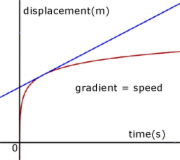
For a displacement-time graph, the gradient at a point is equal to the speed .
Speed-Time graphs
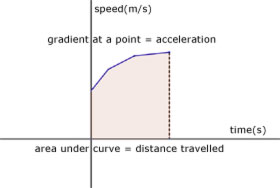
For a speed-time graph, the area under the curve is the distance travelled.
The gradient at any point on the curve equals the acceleration.
![]()
Note, the acceleration is also the second derivative of a speed-time function.
Equations of Motion
One of the equations of motion stems from the definition of acceleration:
acceleration = the rate of change of speed
![]()
rearranging,
![]()
if we define the distance 's' as the average speed times the time(t), then:
![]()
rearranging,
![]()
rearranging (i
![]()
subtracting these two equations to eliminate v,
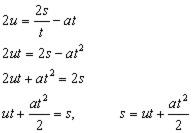
It is left to the reader to show that :
![]()
hint: try multiplying the two equations instead of subtracting
summary:

Example #1
A car starts from rest and accelerates at 10 ms-1 for 3 secs.
What is the maximum speed it attains?
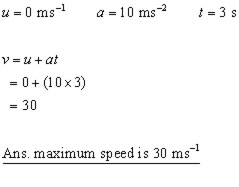
Example #2
A car travelling at 25 ms-1 starts to decelerate at 5 ms-2.
How long will it take for the car to come to rest?
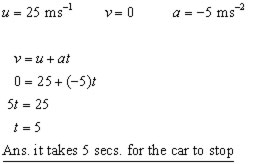
Example #3
A car travelling at 20 ms-1 decelerates at 5 ms-2.
How far will the car travel before stopping?
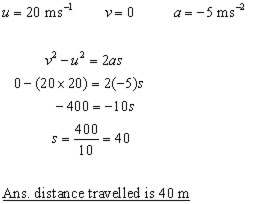
Example #4
A car travelling at 30 ms-1 accelerates at 5 ms-2 for 8 secs.
How far did the car travel during the period of acceleration?
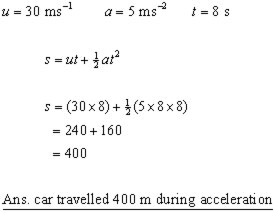
Vertical motion under gravity
These problems concern a particle projected vertically upwards and falling 'under gravity'.
In these types of problem it is assumed that:
air resistance is minimal |
displacement & velocity are positive(+) upwards & negative(-) downwards |
acceleration(g) always acts downwards and is therefore negative(-) |
acceleration due to gravity(g) is a constant |
Example #1
A stone is thrown vertically upwards at 15 ms-1.
(i) what is the maximum height attained?
(ii) how long is the stone in the air before hitting the ground?
(Assume g = 9.8 ms-2. Both answers to 2 d.p.)
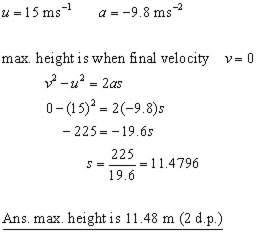

Example #2
A boy throws a stone vertically down a well at 12 ms-1.
If he hears the stone hit the water 3 secs. later,
(i) how deep is the well?
(ii)what is the speed of the stone when it hits the water?
(Assume g = 9.8 ms-2. Both answers to 1 d.p.)
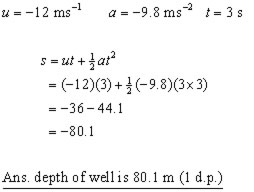
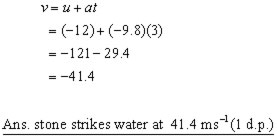
[ About ] [ FAQ ] [ Links ] [ Terms & Conditions ] [ Privacy ] [ Site Map ] [ Contact ]
